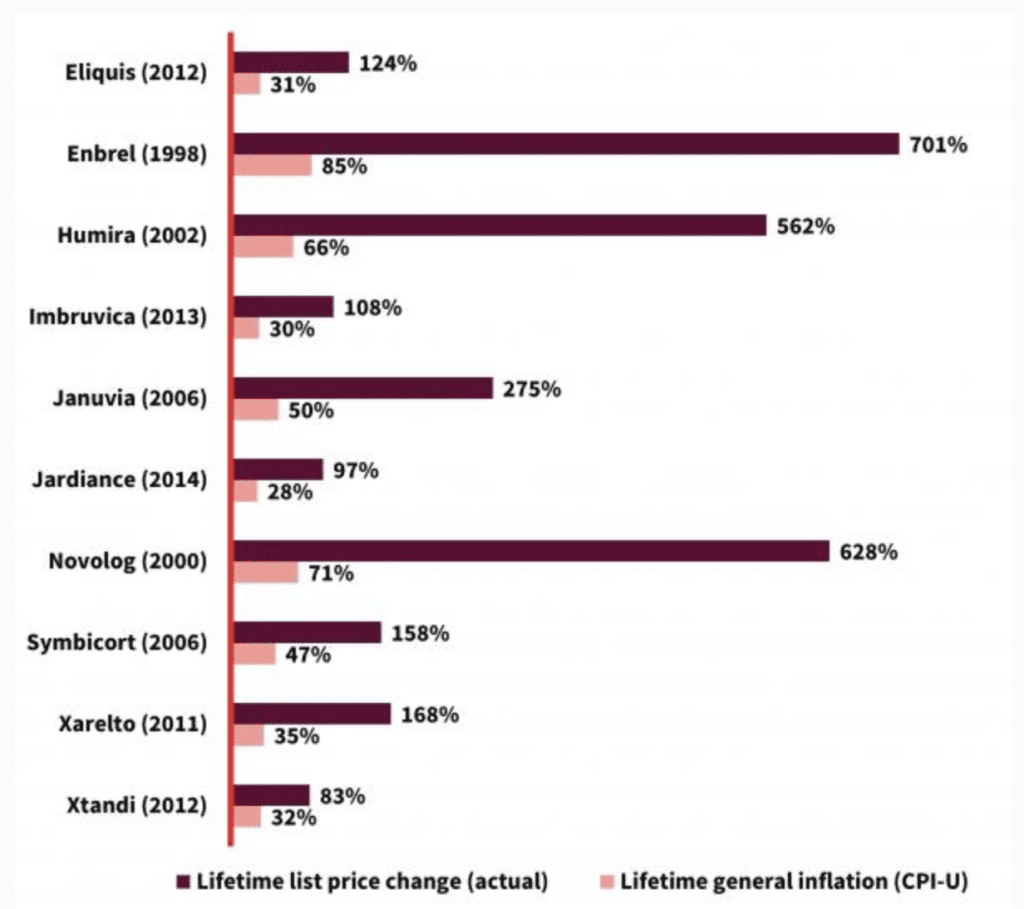Search Posts
Recent Posts
- U.S. Carries Out Limited Strike on Iran’s Known Nuclear Sites June 22, 2025
- A Greener View: E. Coli vs. Vegetables, and Your Garden – Jeff Rugg June 22, 2025
- Rhode Island Weather for June 22, 2025 – Jack Donnelly June 22, 2025
- Ask Chef Walter: The Art and Science of Baking – Chef Walter Potenza June 22, 2025
- Gimme’ Shelter: Aurora is waiting for a home at the Providence Animal Control Center June 22, 2025
Categories
Subscribe!
Thanks for subscribing! Please check your email for further instructions.

Wake up call on spiraling brand-name drug prices – Herb Weiss
By Herb Weiss, contributing writer on aging issues
A new pharmaceutical drug price report that is both timely and overdue has been released by AARP’s Public Policy Institute, following on the heels of the Centers for Medicare & Medicaid Services (CMS) releasing in June, which revised guidance for the historic Medicare Drug Price Negotiation Program.
This report details the list prices for the 25 brand-name drugs with the highest total Medicare Part D spending in 2021, noting that prices have increased by an average of 226%—or more than tripled—since they first entered the market. Those 25 drugs were responsible for $80.9 billion in total Medicare Part D spending in 2021, about 37% of the total spending, and were used by more than 10 million Part D enrollees. It noted that, on average, nearly 60% of their current list price was due to price increases after the product entered the market.
The price of Enbrel, used to treat rheumatoid arthritis and psoriatic arthritis, has increased by 701% since coming to market in 1998, and the price of Januvia, used to treat diabetes, has increased by 275% since entering the market in 2006.
Overall, the lifetime price increases ranged from 20% to 739%, and all but one of the drugs’ lifetime price increases greatly exceeded the annual rate of inflation over the same period of time.
Brand-name drug prices increase faster than inflation has – for decades
“Brand-name drug prices have increased dramatically faster than inflation for decades,” said Leigh Purvis, Prescription Drug Policy Principal, AARP Public Policy Institute, and author of the report. “The median price of a new brand-name prescription drug is now approximately $200,000 per year, so even relatively small percentage price increases can translate into thousands of dollars and put life-saving medications out of reach of the patients who need them,” she said.
“We know that there is lot of media attention on individual drug prices that take place year after year. However, a lot less attention is paid to how those price increases are often building on top of a long line of price increases and how those relentless price increases add up over time,” says Purvis, during a press call to journalists scheduled on the day of the report’s release.
“These findings have huge implications for the people that AARP represents, many of whom need prescription drugs to help them stay well,” Purvis said. “People on Medicare prescription drug plans take on average of between 4 and 5 prescription drugs per month and their drugs are increasing covered using coinsurance where you pay a percentage of the drugs price instead of a flat co-pay. In fact, across the country more and more people are facing cost sharing directly affected by drug price increases, whether it is by coinsurance or simply before they meet their deductible. Millions of other people don’t have health coverage and are having to absorb the cost associated with growing drug prices on their own,” she said.
“Our analysis shows that drugs that have been on the market for twenty years or more have seen an average lifetime price increase of 592 percent. In real terms this can be the difference of thousands of dollars for one person and enough to force the trade-offs that we often hear about, like choosing to put food on the table or being able to pay for gas,” notes Purvis.
“There is no justification for drug companies to engage in these type of price increases every year they are on the market, particularly increases that are so much higher than the price increases for other goods and services,” adds Purvis.
CMS releases revised guidance for negotiating with drug manufacturers
Congress recently passed the Inflation Reduction Act (IFA), a federal law requiring drug companies to pay a penalty to Medicare if their drug’s price increases faster than the rate of inflation. The law will also give Medicare the ability to negotiate lower drug prices with drug companies for the first time. CMS is expected to announce the first 10 drugs selected for negotiation by September 1st, and the negotiated prices will become available in 2026.

“This historic law cracks down on the big drug companies and [will bring] real relief to millions of seniors who have been struggling with out-of-control prescription drug prices,” said Nancy LeaMond, AARP Executive Vice President and Chief Advocacy and Engagement Officer. “American families simply can’t afford to keep paying the highest prices in the world for the medications they need.”
Last March, CMS issued initial guidance to seek comments on its historic Medicare Drug Negotiation Program. The agency received over 7,500 comments from consumer, patient groups, drug companies and pharmacies. In June, CMS released its revised guidelines detailing the requirements and parameters of how the agency will oversee the new program.
“Issuing final guidance for the Medicare Drug Price Negotiation Program is an important “next step” in controlling spiraling high drug prices, says AARP’s LeaMond, noting that Medicare’s new buying power will get a better price for Medicare beneficiaries, saving the program billions of dollars and making prescription drugs more affordable.
Opposition, of course
At press time, the Pharmaceutical Research and Manufacturers of America (PhRMA), the leading industry lobby group for pharmaceutical companies, along with a group of pharmaceutical companies and trade groups, are suing the U.S. Health and Human Services to block the implementation of the Medicare Drug Price Negotiation Program established by the Inflation Reduction Act enacted by President Biden last August. The U.S. Chamber of Commerce has also filed a lawsuit in a U.S. District Court in Ohio to ask for an injunction to keep the negotiations from going forward. The trade group is challenging the constitutionality of the IFA’s drug price negotiation program.
It’s a very high lift and big burden to meet the standard to stop the law from being implemented,” noted Kelly Bagby, AARP’s Vice President at AARP Foundation Litigation, before AARP’s press call ended.
“It is entirely appropriate and is necessary and the public interest is so enormous in balancing of the government’s interest verses the pharmaceutical companies and Chamber’s interest in this case,” says Bagby,” stressing that beneficiaries have to win this case. “It’s so obvious that pharmaceutical companies are not the victims they are painting themselves to be, she adds, affirming her belief that beneficiaries and Medicare have the strongest argument.
Bagby noted, “AARP is working to protect the integrity of whole Medicare program for everybody and to allow for older people to not have to make horrible choices about do I pay my rent or do I get to take my life saving drugs.”
Reports a Wake-Up Call
Although PhRMA, pharmaceutical companies and trade groups along with the U.S. Chamber are strongly opposed to CMS’s new program to negotiation drug prices, polls show that people aged 50 and over, view the lowering of the price of costly prescription drugs to be a very important policy issue to them. Purvis hopes that the recently released AARP report will serve as a wake-up call for every American who is skeptical about the importance of lowering prescription drug prices. “Higher government spending driven by drug price increases will affect all Americans in the form of higher taxes, cuts to public programs, or both,” she predicts.
For a copy of AARP’s Medicare Part D Drug Price report, go to https://www.aarp.org/pri/topics/health/prescription-drugs/prices-top-medicare-part-d-drugs-tripled-since-entering-market.html.
___

Herb Weiss, LRI -12, is a Pawtucket-based writer who has covered aging, health care and medical issues for over 43 years. To purchase his books, Taking Charge: Collected Stories on Aging Boldly and a sequel, compiling weekly published articles, go to herbweiss.com.


Herb
I come from a pharmacist family although I, myself, am not a pharmacist. My grandfather and his brother were both pharmacists. My father and his brother, my uncle, were both pharmacists. They operated Davis Drug Store in Pawtucket for several generations, initially on Main Street in downtown and later on Walcott St. and Pawtucket Avenue. My grandfather worked for Dr.Charles Davis and eventually bought the original store from him. I am the only person alive who knows the secret to making Dr. Davis hard candy, an almost must have during the Christmas holidays then. Some of your octogenarian and older readers might recall buying it. Commercially, my father and I were the last people to make while I was still a student at St. Raphael.
But this comment is directed to a different point of view. No one can walk into a pharmacy and order these drugs over the counter. Only a certified medical professional can write the needed prescription. Yet we are constantly bombarded, day and night, on the radio, TV, newspaper ads, magazines, billboards, and every other place an ad might be found. And the cost for all these ads is beyond imagination for a product that no one can buy without a prescription. There was a time when drug companies could not and did not advertise prescription medications. They sent representatives to medical offices to pitch their spiels. Most people are aware that under-the-counter rewards, trips, etc. (what most people call bribes) resulted. The courts cracked down.
It is expensive to bring a new prescription to the market place, and rightly so, but it would be a lot cheaper if the media ads were eliminated. Today, it seems like the drug companies no longer invest heavily in representatives visiting doctors and pharmacies, mainly because the viewing public does it for them. Everyone is looking for that magic pill or tonic. Puts a different spin on the term ‘snake oil’.